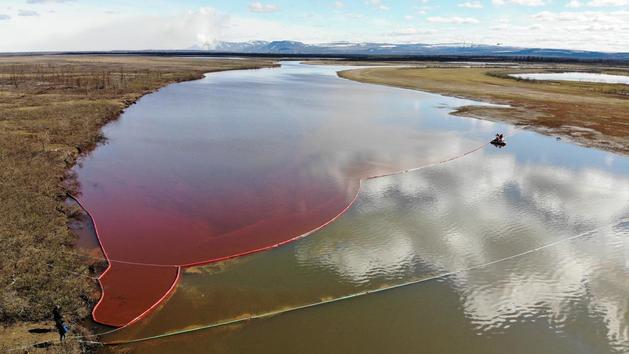The industrial and ecological disaster has been described as " unprecedented ". Friday, May 29, one of the fuel tanks of a thermal power plant collapsed near the arctic city of Norilsk in Siberia, leaving 21,000 tons of hydrocarbon in the wild.
Read also: The thaw of "permafrost", a climate bomb still poorly quantified
Friday, June 5, a week to the day after the tragedy, the Russian authorities said they had finally stopped the progression of hydrocarbons.
Back on one of the worst ecological disasters in Siberia.
- "An accident unprecedented in scale"
On May 29, the collapse of a diesel tank at the Norilsk thermal power plant belonging to the mining giant Norilsk Nickel caused a leak of 15,000 tonnes of oil in the nearby river and 6,000 tonnes on the surrounding land.
" It is an accident unprecedented in its scale, " commented Friday June 5 Sevtalna Radionova, who heads Rosprirodnadzor, the Russian environmental policeman. The accident is so serious that Russian President Vladimir Putin declared a state of emergency on Wednesday June 3.
Norilsk Nickel's site in Norilsk IRINA YARINSKAYA / AFP
" There has never been such a leak in the Arctic before, " said the spokesman for the Russian marine emergency service, specialized in these accidents. You have to work very quickly because the fuel is dissolving in the water . ” For Greenpeace Russia, this accident is " the first on this scale in the Arctic ". The Russian Fisheries Agency has estimated that it will take decades for the ecosystem to recover.
Pollution is even visible from space. On the images of the European Space Agency (ESA), which date from June 1, we can see several branches of the river tinged with red over a length of more than two kilometers.
European Space Agency (ESA) images show the waters of the river tinged with red. ESA / ESA via REUTERS
- The progression of the “ stopped” fuel tide
The increase in pollution was halted thanks to the deployment of a floating containment dam. Rescuers are mobilized to try to limit the damage, in a context complicated by the difficulties of access, the shallow depth of the river preventing operations by boat, and the marshy terrain in spring.
Rescuers pumped the oil and stored it on site in containers until winter, when the frost has made the area more practical. So far, 200 tonnes have been removed from the water.
Given the gravity of the situation, the United States offered to help on Saturday June 6. " Despite our disagreements, the United States stands ready to help Russia end this environmental disaster and provide technical expertise ," said Secretary of State Mike Pompeo in a tweet.
- The wrath of Vladimir Putin
" Is everything all right in your head?" ", Vladimir Putin got angry against Vladimir Potanin, the wealthy boss of Norilsk Nickel. " Why were government agencies not informed until two days after the fact? Are we going to learn emergency situations on social networks? ", He continued during a videoconference on June 3. " If you had changed in time [this tank] , there would have been no damage ."
Vladimir Putin on June 3. ALEXEY NIKOLSKY / AFP
" Not a single ruble from the federal budget will come out, " promised the boss of Norilsk Nickel in response to criticism from Vladimir Putin. He estimated the cost of operations at 10 billion rubles (or 128 million euros).
To understand the causes of the disaster, the Russian Investigative Committee announced the opening of three criminal investigations and the head of the plant has already been arrested and placed in pre-trial detention.
Norilsk Nickel, one of the world's leading producers of nickel and palladium, has not had its first ecological accident: in 2016, one of its factories inadvertently dumped chemicals in a river near the current disaster.
So far, 200 tonnes have been removed from the water. YURI KADOBNOV / AFP
- Permafrost freezing as a possible cause
The melting of permafrost is advanced as one of the possible explanations for the collapse of the reservoir. These year-round frozen soils cover a quarter of the land mass in the northern hemisphere, especially in Russia, Canada and Alaska, and are very loaded with carbon dioxide (CO2).
Read also: Ludovic Ravanel: "The melting of permafrost is a real danger"
The Russian government considers this thaw in the Arctic, where the exploitation of natural resources is a strategic priority of the Kremlin, as a major risk with unforeseeable consequences. In addition to the release of CO2 (permafrost contains twice the amount of CO2 from the atmosphere), and bacteria and viruses sometimes locked up for millions of years, the melting of permafrost causes a lot of material damage. According to a study published in December 2018 in Nature Communications, it threatens, by 2050, up to 70% of infrastructure in the Arctic, including oil and gas fields, and 3.6 million people could be affected by this damage .
Russia on Friday (June 4th) ordered a full audit of its risky infrastructure built on permafrost, weakened by climate change.
Another cause has, however, been advanced. The infrastructure inspection body Rostekhnadzor, quoted by the TASS agency, said it had not been able to check since 2016 the condition of the tank, in operation for 35 years, because Norilsk Nickel claimed that it was under repair.

